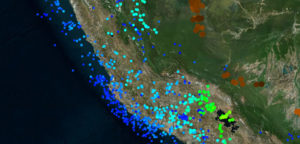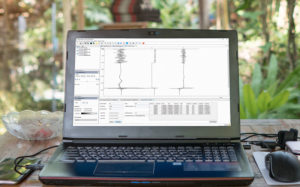How Window Synchronization Facilitates Visualization of a Large Number of Datasets
While some customers will use the portability of INTViewer to present their data, others will use INTViewer on a workstation, with multiple monitors. And instead of opening a handful of windows, they will open a few dozen. The typical use case for opening a large number of windows is when you want to monitor the multiple steps of a processing workflow. In such a use case where datasets are compared, it’s important that all visualizations share the same settings. INTViewer makes it really easy to open dozens of datasets at once. You can select a directory and open in one click all the datasets within that directory. But this is not where INTViewer’s productivity stops. Automatic synchronization facilitates the management of all these windows.
Using INTViewer to Visualize Earthquakes and Other Seismic Activity
I often have a hard time explaining to friends and family what exactly INTViewer does. The moment I use the word “seismic,” the listener's mind automatically shifts to the topics of seismic activity and earthquakes, and I need to explain oil & gas exploration technologies before I even get to the software. By then, I have lost my audience. Today, I’ll try a different technique: I’ll describe the capabilities of INTViewer that actually cater to earthquake mapping. I will show how you can use the built-in capabilities of INTViewer to map recent earthquake activities.
5 Ways INTViewer Makes Offline Visualization Possible
I often say that INTViewer is a bit of Swiss knife. It serves multiple purposes, and each company finds a different use. This makes it hard to decide which feature to highlight. In the past few years, as the industry moved to the cloud, we created a companion for INTViewer: INTGeoServer, which makes it easy to visualize data beyond the bounds of your network. This year, with the new release of INTViewer approaching, I will highlight the opposite feature of INTViewer: its ability to work offline, disconnected from the world.
How the NetBeans Module System Helps Us Maintain Compatibility Between Releases
Two decades after its creation, the Java runtime has finally become modular. A modular approach not only makes dependency management easier, but it also makes applications more efficient as unused modules don’t need to be loaded. The NetBeans Platform predates Java 9 and has been using its own module system for years. Since INTViewer is a desktop application built on top of the NetBeans Platform, I find that it is far superior to the Java 9 module system for my use cases.
What Cloud Data Lakes Mean for Geoscience
With the explosion of storage capacity, cloud computing, and bandwidth availability, a trend has emerged in the oil and gas industry over the last few years. Data that was previously aggregated and discarded is now maintained and stored, creating an opportunity for the industry. Coupled with new advancements in machine learning and Al, this data availability is poised to drive more data driven decision making in well planning, drilling & completions, and well operations.





